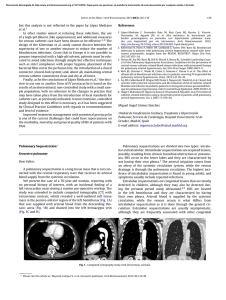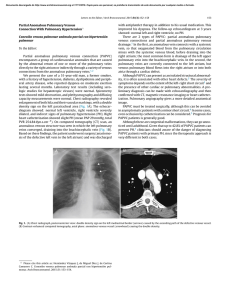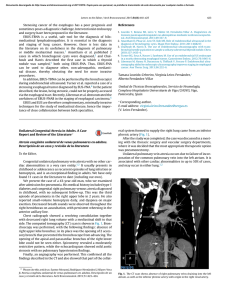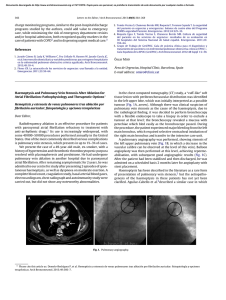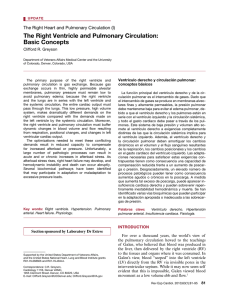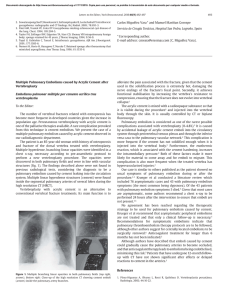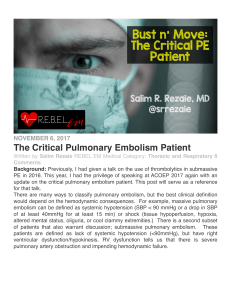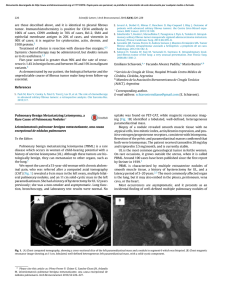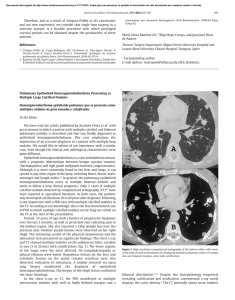A Clinical Prediction Rule for Identifying Short
Anuncio
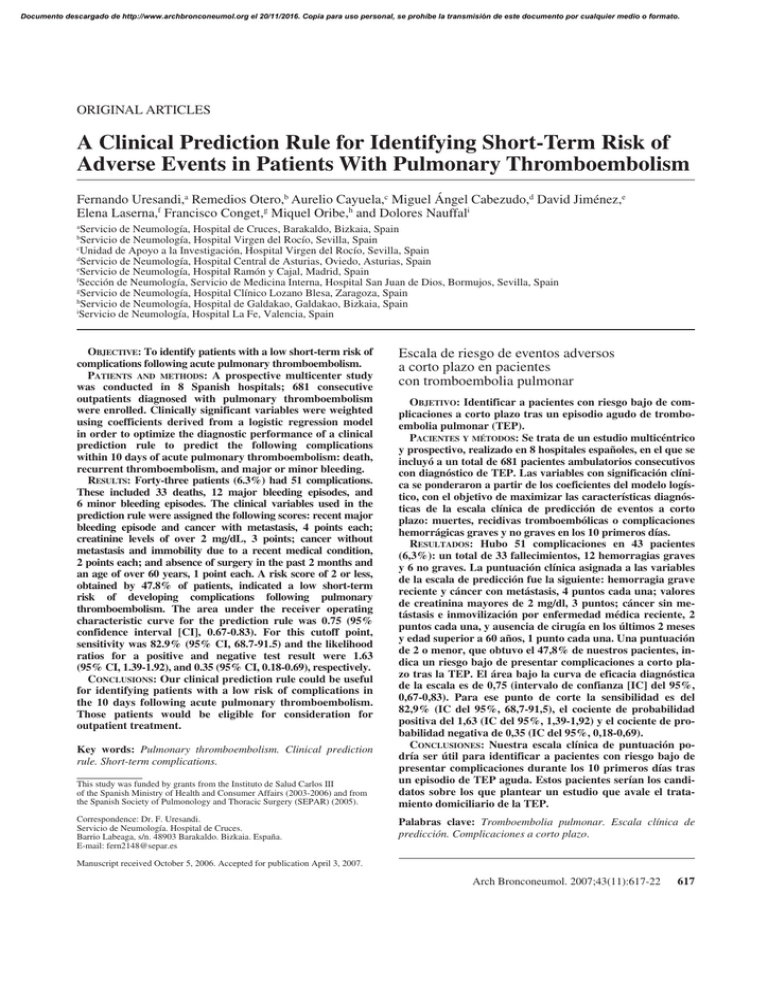
Documento descargado de http://www.archbronconeumol.org el 20/11/2016. Copia para uso personal, se prohíbe la transmisión de este documento por cualquier medio o formato. ORIGINAL ARTICLES A Clinical Prediction Rule for Identifying Short-Term Risk of Adverse Events in Patients With Pulmonary Thromboembolism Fernando Uresandi,a Remedios Otero,b Aurelio Cayuela,c Miguel Ángel Cabezudo,d David Jiménez,e Elena Laserna,f Francisco Conget,g Miquel Oribe,h and Dolores Nauffali a Servicio de Neumología, Hospital de Cruces, Barakaldo, Bizkaia, Spain Servicio de Neumología, Hospital Virgen del Rocío, Sevilla, Spain c Unidad de Apoyo a la Investigación, Hospital Virgen del Rocío, Sevilla, Spain d Servicio de Neumología, Hospital Central de Asturias, Oviedo, Asturias, Spain e Servicio de Neumología, Hospital Ramón y Cajal, Madrid, Spain f Sección de Neumología, Servicio de Medicina Interna, Hospital San Juan de Dios, Bormujos, Sevilla, Spain g Servicio de Neumología, Hospital Clínico Lozano Blesa, Zaragoza, Spain h Servicio de Neumología, Hospital de Galdakao, Galdakao, Bizkaia, Spain i Servicio de Neumología, Hospital La Fe, Valencia, Spain b OBJECTIVE: To identify patients with a low short-term risk of complications following acute pulmonary thromboembolism. PATIENTS AND METHODS: A prospective multicenter study was conducted in 8 Spanish hospitals; 681 consecutive outpatients diagnosed with pulmonary thromboembolism were enrolled. Clinically significant variables were weighted using coefficients derived from a logistic regression model in order to optimize the diagnostic performance of a clinical prediction rule to predict the following complications within 10 days of acute pulmonary thromboembolism: death, recurrent thromboembolism, and major or minor bleeding. RESULTS: Forty-three patients (6.3%) had 51 complications. These included 33 deaths, 12 major bleeding episodes, and 6 minor bleeding episodes. The clinical variables used in the prediction rule were assigned the following scores: recent major bleeding episode and cancer with metastasis, 4 points each; creatinine levels of over 2 mg/dL, 3 points; cancer without metastasis and immobility due to a recent medical condition, 2 points each; and absence of surgery in the past 2 months and an age of over 60 years, 1 point each. A risk score of 2 or less, obtained by 47.8% of patients, indicated a low short-term risk of developing complications following pulmonary thromboembolism. The area under the receiver operating characteristic curve for the prediction rule was 0.75 (95% confidence interval [CI], 0.67-0.83). For this cutoff point, sensitivity was 82.9% (95% CI, 68.7-91.5) and the likelihood ratios for a positive and negative test result were 1.63 (95% CI, 1.39-1.92), and 0.35 (95% CI, 0.18-0.69), respectively. CONCLUSIONS: Our clinical prediction rule could be useful for identifying patients with a low risk of complications in the 10 days following acute pulmonary thromboembolism. Those patients would be eligible for consideration for outpatient treatment. Key words: Pulmonary thromboembolism. Clinical prediction rule. Short-term complications. This study was funded by grants from the Instituto de Salud Carlos III of the Spanish Ministry of Health and Consumer Affairs (2003-2006) and from the Spanish Society of Pulmonology and Thoracic Surgery (SEPAR) (2005). Correspondence: Dr. F. Uresandi. Servicio de Neumología. Hospital de Cruces. Barrio Labeaga, s/n. 48903 Barakaldo. Bizkaia. España. E-mail: fern2148@separ.es Escala de riesgo de eventos adversos a corto plazo en pacientes con tromboembolia pulmonar OBJETIVO: Identificar a pacientes con riesgo bajo de complicaciones a corto plazo tras un episodio agudo de tromboembolia pulmonar (TEP). PACIENTES Y MÉTODOS: Se trata de un estudio multicéntrico y prospectivo, realizado en 8 hospitales españoles, en el que se incluyó a un total de 681 pacientes ambulatorios consecutivos con diagnóstico de TEP. Las variables con significación clínica se ponderaron a partir de los coeficientes del modelo logístico, con el objetivo de maximizar las características diagnósticas de la escala clínica de predicción de eventos a corto plazo: muertes, recidivas tromboembólicas o complicaciones hemorrágicas graves y no graves en los 10 primeros días. RESULTADOS: Hubo 51 complicaciones en 43 pacientes (6,3%): un total de 33 fallecimientos, 12 hemorragias graves y 6 no graves. La puntuación clínica asignada a las variables de la escala de predicción fue la siguiente: hemorragia grave reciente y cáncer con metástasis, 4 puntos cada una; valores de creatinina mayores de 2 mg/dl, 3 puntos; cáncer sin metástasis e inmovilización por enfermedad médica reciente, 2 puntos cada una, y ausencia de cirugía en los últimos 2 meses y edad superior a 60 años, 1 punto cada una. Una puntuación de 2 o menor, que obtuvo el 47,8% de nuestros pacientes, indica un riesgo bajo de presentar complicaciones a corto plazo tras la TEP. El área bajo la curva de eficacia diagnóstica de la escala es de 0,75 (intervalo de confianza [IC] del 95%, 0,67-0,83). Para ese punto de corte la sensibilidad es del 82,9% (IC del 95%, 68,7-91,5), el cociente de probabilidad positiva del 1,63 (IC del 95%, 1,39-1,92) y el cociente de probabilidad negativa de 0,35 (IC del 95%, 0,18-0,69). CONCLUSIONES: Nuestra escala clínica de puntuación podría ser útil para identificar a pacientes con riesgo bajo de presentar complicaciones durante los 10 primeros días tras un episodio de TEP aguda. Estos pacientes serían los candidatos sobre los que plantear un estudio que avale el tratamiento domiciliario de la TEP. Palabras clave: Tromboembolia pulmonar. Escala clínica de predicción. Complicaciones a corto plazo. Manuscript received October 5, 2006. Accepted for publication April 3, 2007. Arch Bronconeumol. 2007;43(11):617-22 617 Documento descargado de http://www.archbronconeumol.org el 20/11/2016. Copia para uso personal, se prohíbe la transmisión de este documento por cualquier medio o formato. URESANDI F ET AL. A CLINICAL PREDICTION RULE FOR IDENTIFYING SHORT-TERM RISK OF ADVERSE EVENTS IN PATIENTS WITH PULMONARY THROMBOEMBOLISM Introduction Pulmonary thromboembolism can display a wide spectrum of clinical presentations, which can range from practically no symptoms or hemodynamic repercussions to hemodynamic shock or instability.1 Overall, the condition is associated with a high proportion of deaths and recurrent events, despite treatment, and with frequent bleeding complications due to anticoagulation.2 Mortality and morbidity, however, can vary considerably depending on the severity of the acute episode and the patient´s prior comorbidities; this means that varying strategies can be used to manage different patients. Since low-molecular-weight heparin was adopted as the treatment of choice for deep vein thrombosis and pulmonary thromboembolism several years ago,3 many patients with deep vein thrombosis have been treated successfully on an outpatient basis, with no adverse impact on either safety or efficacy.4,5 The experience with pulmonary thromboembolism, however, is more limited.68 Kovacs et al,7 using traditional exclusion criteria based on severity for the outpatient treatment of pulmonary embolism (hemodynamic instability and respiratory failure, comorbidity, high risk of bleeding, and pain requiring the administration of parenteral analgesics), found a complication rate of 11.1% at 3 months, where complications were defined as death, recurrent events, and major bleeding. This figure rose to 15.7% when minor bleeding was considered. A number of studies have identified clinical risk factors for death9 and recurrent thromboembolism,10 and developed risk classifications for bleeding.11 Wicki et al,12 working at Geneva University Hospital in Switzerland, developed a clinical risk score (which has been validated externally13) for predicting adverse outcome—which they defined as death, recurrent thromboembolism, or bleeding complications—in the 3 months following the acute phase. More recently, Aujesky et al14 published a prognostic model designed exclusively to predict death at 30 days in patients with pulmonary embolism; their model has also been validated externally.15 Most patients with pulmonary thromboembolism, however, are discharged from hospital within 7 to 12 days of an acute episode. This means that patients at risk of developing complications of any type (including less serious complications that cause concern, such as minor bleeding) within this initial period would not be considered for full or partial outpatient treatment of their condition. Current evidence indicates that traditional severity criteria are not sufficient for predicting short-term adverse events, and moreover, existing prediction rules do not cover all the possible types of complications that could arise during this initial period. Our hypothesis is that patients who have a low risk of adverse events in the short term (normal hospitalization period) could be treated with equal safety and efficacy at home as in hospital. To identify these patients at low risk of complications, however, we need an objective tool that analyzes more than just traditional clinical severity criteria. The aim of this study was to create a clinical prediction rule for short-term adverse events that could be used to study whether a patient 618 Arch Bronconeumol. 2007;43(11):617-22 might be eligible for partial or full outpatient treatment following acute pulmonary thromboembolism. Patients and Methods The study followed standard epidemiological methods for prediction rules, which recommend using both objective prediction variables and evaluation variables. It was approved by the ethics committees at each of the participating hospitals and forms part of the preliminary research for clinical trial number NCT00214928 registered with the US National Institutes of Health and US Food and Drug Administration. Patients The study enrolled consecutive outpatients who visited the emergency department at 8 Spanish hospitals and were diagnosed with pulmonary thromboembolism. The enrollment period was from December 1, 2003 to August 31, 2004 in all but 2 hospitals: Hospital de Cruces in Bizkaia and Hospital Virgen de Rocío in Seville, where enrollment began on March 1, 2001 and November 1, 2002, respectively. The only exclusion criterion was noncompliance with diagnostic criteria for pulmonary thromboembolism. Diagnostic Criteria for Pulmonary Thromboembolism The following diagnostic criteria were used to determine the presence of pulmonary thromboembolism: computed tomography (CT) angiography showing an abrupt interruption of contrast material flow in the pulmonary arteries, or an intraluminal filling defect in 2 consecutive slices; a ventilation– perfusion lung scan rated as high probability according to the prospective investigation of pulmonary embolism diagnosis (PIOPED) criteria 16; and clinical suspicion of pulmonary thromboembolism and a venous ultrasound of the legs, with or without Doppler, showing proximal deep vein thrombosis (noncompressibility of a venous segment). Clinical Variables We used the clinical variables from the computerized database of thromboembolic disease in Spain (RIETE; www.riete.org). Prior to the study, we added several variables to the database that were designed to be recorded only by the participating hospitals. We recorded patient characteristics (sex and age); admission and discharge dates; clinical variables (systolic blood pressure, heart rate, pulmonary thromboembolism symptoms such as dyspnea, chest pain, syncope, hemoptysis, cough, and fever, and concomitant deep-vein thrombosis symptoms such as painful or swollen limbs); comorbidity (heart failure, chronic bronchial disease, others); concomitant medication (antiplatelet agents, nonsteroidal anti-inflammatory drugs, others); major bleeding episodes in the past month; arterial blood gas analysis on admission; chest radiograph findings (atelectasis, pleural effusion, pulmonary infarctions, enlarged heart, increased density); electrocardiogram findings (rhythm, signs of right heart overload); CT angiography or ventilation–perfusion lung scan findings, with location of thrombi (main branches of pulmonary arteries and lobar, segmental, and subsegmental branches); arteriography findings; venous ultrasound findings and location of proximal or distal venous thrombi; risk factors for venous thromboembolic disease such as cancer, previous surgery, a history of venous thromboembolic disease, immobilization due to a medical condition, a recent long-distance journey, hormone therapy, Documento descargado de http://www.archbronconeumol.org el 20/11/2016. Copia para uso personal, se prohíbe la transmisión de este documento por cualquier medio o formato. URESANDI F ET AL. A CLINICAL PREDICTION RULE FOR IDENTIFYING SHORT-TERM RISK OF ADVERSE EVENTS IN PATIENTS WITH PULMONARY THROMBOEMBOLISM pregnancy, birth, and varicose veins; routine laboratory results (creatinine, hemoglobin, leukocytes, platelets); D-dimer levels; T-troponin levels; hereditary thrombophilia; and echocardiogram findings (systolic pulmonary artery pressure and right ventricular dysfunction data). The significance of the clinical variables was defined by the team of researchers. Immobilization due to a medical condition was defined as immobilization of over 4 days for a reason other than surgery. Previous surgery was surgery performed in the preceding 2 months, and a recent long-distance journey was a journey undertaken in the preceding 3 weeks, by any means of transport, that lasted for over 6 hours. Birth was considered when the patient had given birth in the preceding 2 months. Disease stage (with or without metastasis) was recorded for all patients with cancer, and creatinine levels were considered to be high when they exceeded 2 mg/dL. Result Evaluation Variables Complications that occurred in the first 10 days were recorded; these included death, recurrent thromboembolism, and major or minor bleeding. Cause of death was determined in accordance with the clinical impression of the supervising physician and a review of the patient´s chart. The criteria for recurrent thromboembolism were the presence of clinical signs and symptoms with confirmation by imaging techniques (CT angiography, ventilation—perfusion lung scan, venous ultrasound of the legs, or arteriography). The criteria for major bleeding included intracerebral or retroperitoneal bleeding, the need for the transfusion of 2 or more units of packed red blood cells or surgery, and a reduction in hemoglobin levels of over 2 g/dL. Minor bleeding was defined as the presence of clinically relevant TABLE 1 Adverse Events Recorded in the First 10 Days Following Pulmonary Thromboembolism (n=681) Deaths Pulmonary thromboembolism Bleeding Other causes Major bleeding Minor bleeding Recurrent events Total* 33 16 4 13 12 6 0 51 4.8% 2.3% 0.6% 1.9% 1.8% 0.9% 0 7.5% bleeding that did not meet the above criteria; this included bleeding that required a reduction in low-molecular-weight heparin or the monitoring of low-molecular-weight heparin concentration by analysis of anti-factor Xa activity. Clinical Prediction Rule Each variable included in the clinical prediction rule was assigned a score according to the magnitude of the corresponding odds ratio, which was determined by univariate analysis for each complication (death, recurrent thromboembolism, or bleeding). We introduced several modifications based on our clinical judgment to optimize the sensitivity and specificity of the prediction rule. Statistical Analysis A descriptive analysis was performed using absolute and relative frequencies for qualitative variables and means (SD) for quantitative variables. Patients with and without complications were compared using the χ2 test for qualitative variables and the t test for quantitative variables. To create the scoring system, we weighted clinically significant variables using coefficients derived from a logistic regression model in order to optimize the diagnostic performance of the prediction rule. Using the receiver operating characteristic (ROC) curve, a graph plotting sensitivity along the Y axis and the fraction of false positives (1-specificity) along the X axis, we established the cutoff for maximum diagnostic discrimination and the overall diagnostic accuracy, which was determined from the area under the curve. The diagnostic characteristics of each variable were estimated by calculating sensitivity, specificity, negative and positive predictive values, and likelihood ratios. Statistical analyses were performed using the SPSS statistical package, version 12.01 for Windows. Results *Total number of patients that developed complications: 43/681 (6.3%). Four patients died due to major bleeding; 1 patient who died from other causes and 3 patients who died from pulmonary thromboembolism had minor bleeding. We obtained clinical data for 681 patients (336 men [49.3%] and 345 women [50.7%]) with a mean age of 68 years. Forty-three patients (6.3%) developed 51 complications in the first 10 days (Table 1). The patients´ characteristics and the association between these and adverse events according to the univariate analysis are shown in Table 2. TABLE 2 Patient Characteristics and Association With Adverse Events* Characteristics No. Men Age >60 y History of nonmetastatic cancer History of metastatic cancer History of pulmonary thromboembolism not due to surgery History of immobilization History of recent bleeding Pain in lower limbs Swelling in lower limbs Chest pain Elevated creatinine levels (>2.0 mg/dL) 336 521 57 62 592 142 10 182 196 327 191 Patients With Adverse Events, No. (%) 19 (5.7) 38 (7.3) 4 (7) 8 (13) 42 (7.1) 17 (12) 2 (20) 6 (3.3) 6 (3.1) 10 (3.1) 24 (12.6) OR (95% CI ) P 0.8 (0.4-1.4) 2.4 (0.9-6.3) 1.31 (0.32-3.94) 2.5 (2.03-6.25) 6.7 (0.9-49) 2.6 (1.4-5.0) 3.8 (0.7-18.6) 0.4 (0.1-1) 0.3 (0.1-0.9) 0.3 (0.1-0.6) 3.7 (1.9-7.1) .48 .05 .39 .02 .031 .002 .07 .049 .025 .001 .001 *CI indicates confidence interval; OR, odds ratio. Arch Bronconeumol. 2007;43(11):617-22 619 Documento descargado de http://www.archbronconeumol.org el 20/11/2016. Copia para uso personal, se prohíbe la transmisión de este documento por cualquier medio o formato. URESANDI F ET AL. A CLINICAL PREDICTION RULE FOR IDENTIFYING SHORT-TERM RISK OF ADVERSE EVENTS IN PATIENTS WITH PULMONARY THROMBOEMBOLISM TABLE 3 Clinical Prediction Rule 1,0 Variables Recent bleeding Metastatic cancer Creatinine >2 mg/dL Nonmetastatic cancer History of immobilization due to medical condition No recent surgery Age >60 y Sensitivity 0.8 0.6 4 4 3 2 2 1 1 0.4 Patients with a score of 2 or less have a low risk of developing short-term complications due to pulmonary thromboembolism. 0.2 TABLE 4 Distribution of Prognostic Scores in Study Group 0.0 0.0 Frequency 0.2 0.4 0.6 0.8 1.0 Valid 1-Specificity Area Under the Curve* Area Standart Error† Two-Tailed Significance‡ 0.754 0.038 0.000 Two-Tailed 95% Confidence Interval Lower Bound Upper Bound 0.679 0.830 Figure. Receiver operating characteristic curve for the clinical prediction rule to determine the short-term risk of adverse events in patients with pulmonary thromboembolism. *There is at least 1 tie between 1 or more variables in the true positive group and the true negative group. Diagonal segments are produced by ties. The statistics may be biased. †Nonparametric inference. ‡Null hypothesis: true area =0.5 Clinical Prediction Rule for Adverse Events The clinical prediction rule (Table 3) assigns a score of 0 to 14; it contains 7 items, of which the following were treated as mutually exclusive: metastatic cancer and nonmetastatic cancer, and immobilization due to a medical condition and no recent surgery. The area under the ROC curve for a cutoff point of 2 was 0.75 (95% confidence interval [CI], 0.67-0.83) (Figure). A total of 320 patients had a score of ≤2, meaning that 47.8% of the patients studied had a low risk of developing complications in the first 10 days (Table 4). Table 5 shows the sensitivity, specificity, positive and negative predictive values, and likelihood ratios for the prognostic model based on our prediction rule. For a cutoff point of 2, the likelihood ratios for a positive and negative test result were 1.63 (95% CI, 1.39-1.92) and 0.35 (95% CI, 0.18-0.69), respectively. 620 Score Arch Bronconeumol. 2007;43(11):617-22 Missing Total 0.00 1.00 2.00 3.00 4.00 5.00 6.00 7.00 8.00 9.00 10.00 11.00 System 26 90 204 37 95 113 24 47 7 23 2 2 11 681 Valid Percent Cumulative Percent 2.9 13.4 30.4 5.5 14.2 16.9 3.6 7.0 1.0 3.4 0.3 0.3 3.9 17.3 47.8 53.3 67.5 84.3 87.9 94.9 96.0 99.4 99.7 99.7 TABLE 5 Application of Predictive Score to Outcome of Pulmonary Thromboembolism* % Sensitivity Specificity Positive predictive value Negative predictive value Estimated pretest likelihood Positive post-test likelihood 1-positive post-test likelihood 1-negative post-test likelihood Negative post-test likelihood 82.9 49.1 11.4 97.3 7.3 11.4 88.6 97.3 2.7 95% CI 68.7-91.5 44.9-53.4 8.3-15.5 94.6-98.7 8.3-15.5 84.5-91.7 94.6-98.7 1.3-5.4 *CI indicates confidence interval. Discussion We designed an original study to develop a clinical prediction rule for identifying patients with a low risk of developing short-term complications following acute pulmonary thromboembolism. We considered a time period of 10 days, which is similar to the standard hospital stay following such an episode. The 2 studies most similar to ours are those by Wicki et al12 and Aujesky et al,14 who Documento descargado de http://www.archbronconeumol.org el 20/11/2016. Copia para uso personal, se prohíbe la transmisión de este documento por cualquier medio o formato. URESANDI F ET AL. A CLINICAL PREDICTION RULE FOR IDENTIFYING SHORT-TERM RISK OF ADVERSE EVENTS IN PATIENTS WITH PULMONARY THROMBOEMBOLISM developed prediction rules for 3 months and 1 month, respectively. We believe that prediction of complications during a routine short-term stay in hospital in patients with acute pulmonary thromboembolism will provide vital information to future researchers investigating the safety and efficacy of the outpatient treatment of acute pulmonary thromboembolism. Unlike the patients studied by Aujesky et al,14 who created a prediction rule for death at 30 days among patients with pulmonary embolism, all of our patients were outpatients who had visited the emergency department of one of the participating hospitals with clinical indications of pulmonary thromboembolism. We did not include hospitalized patients who developed pulmonary thromboembolism while being treated for another disease. Our reasoning was that those patients would not have been eligible for inclusion in an outpatient treatment program as their admission to hospital was justified by another condition. One of the original aspects of our study is that we included minor bleeding in the complications we studied. We believe that this decision is justified because of the discomfort such a complication would cause a patient if it occurred at home. In our opinion, future studies of the outpatient treatment of pulmonary thromboembolism should focus not only on achieving equal safety and efficacy for outpatients and inpatients but also on preventing the discomfort that minor complications could cause outpatients, at least until there is a change in the current mindset regarding the treatment of pulmonary thromboembolism. It is worth noting that we detected no recurrent events in our analysis of the complications that took place in the 10 days following acute thromboembolism. Wicki et al12 reported 7 recurrent events in the first 15 days; 6 of these resulted in death (2%) and 1 did not (0.3%). The difference is probably due to the fact that, in our series, we attributed the deaths due to pulmonary thromboembolism (2.3%) to the hemodynamic consequences of the pulmonary thromboembolism episode responsible for the clinical manifestations on admission and not to a recurrent event. If we exclude minor bleeding (0.9%) from our series, the overall percentage of patients that developed complications (death, recurrent thromboembolism, and major bleeding) in the acute period is similar to that reported by Wicki et al12: 5.4% in the first 10 days in our study and 4.7% in the first 15 days in that of Wicki et al. There are several differences between the clinical variables included and analyzed by Wicki et al12 and Aujesky et al,14 and those employed in this study, and these differences are probably responsible for the slight differences in the items included in the different prediction models. We analyzed essentially those variables contained in the RIETE database; several of these, including recent bleeding and immobilization due to a medical condition had considerable clinical significance in our study but had not been analyzed by either Wicki et al or Aujesky et al. We also detected a significant difference between metastatic and nonmetastatic cancer that influenced the weighting of both of these items in our prediction rule. Creatinine levels had a strong clinical significance in our study. Creatinine had also been analyzed by Aujesky et al, but they observed a smaller percentage of patients with levels of under 2 mg/dL than seen in our study. Age, another important variable, was similar in the 3 studies, as was overall cancer prevalence, which ranged from 15% to 20%. In contrast, variables that reflected hemodynamic status and functional impairment, such as a systolic blood pressure of <100 mm Hg or a Pa02 of <8 kPa (60 mm Hg) were not clinically significant. Both of these parameters, however, were probably distorted when the patients arrived at the hospital, partly because the patients would have been administered oxygen and fluids in the ambulance on their way to hospital, a standard practice in the Spanish health care system. Our prediction rule performed well at identifying patients at risk of developing complications in the 10 days following acute pulmonary thromboembolism, as can been seen by the area under the ROC curve of 0.75 (95% CI, 0.67-0.83). This value is similar to that reported by both Wicki et al12 and Aujesky et al14 (0.82 [95% CI, 0.75-0.87] and 0.78 [95% CI, 0.77-0.8], respectively), and by the studies that validated their prediction models.13,15 In our model, a recent bleeding episode, the presence of metastatic cancer, and creatinine levels of over 2 mg/dL were all independent predictors of a risk of over 10% for the development of short-term complications. An age of over 60 years (79.4% of patients in our series) was also predictive as it caused the cutoff point of 2 to be surpassed in patients with nonmetastatic cancer or with a history of immobilization due to a medical condition (combined percentage of 20.8%). Nevertheless, almost half of our patients (47.8%) had a risk score of 2 or less; this suggests that a large proportion of patients with acute pulmonary thromboembolism could be managed in an alternative manner, reducing hospital stays considerably. The percentage of low-risk patients in our study is similar to that found in low risk and very low risk patients (40.9%) in the original study of Aujesky et al14 and in both the internal14 and external15 validation studies performed (40.8% and 41.5%, respectively). Wicki et al,12 in contrast, found a higher percentage of patients at low risk of developing complications (67.2%), as did the external validation study (79.9%).13 This difference could be due to the different clinical significance of the variables included in their model and in ours. Could our prediction rule be used in isolation to identify patients with a low risk of complications? The answer is probably yes, although the negative predictive value of 97.3% for the cutoff point of 2 would increase if we included variables reported by other authors as indicators of severity, such as low blood pressure or respiratory failure.12 Our study has certain limitations, such as the bias that may have been introduced by the unreliable measurements of systolic blood pressure and PaO2 in some patients on arrival at hospital or the small number of patients in whom troponin T levels were measured or an echocardiogram performed. This prevented us from being able to accurately assess the value of troponin17 or right ventricular dysfuynction18 as predictors of death. We also need internal and external validation studies to support our findings. Arch Bronconeumol. 2007;43(11):617-22 621 Documento descargado de http://www.archbronconeumol.org el 20/11/2016. Copia para uso personal, se prohíbe la transmisión de este documento por cualquier medio o formato. URESANDI F ET AL. A CLINICAL PREDICTION RULE FOR IDENTIFYING SHORT-TERM RISK OF ADVERSE EVENTS IN PATIENTS WITH PULMONARY THROMBOEMBOLISM In conclusion, we have successfully designed a clinical prediction rule that performs well at predicting low risk of complications during the acute phase of pulmonary thromboembolism. The rule could be improved by adding traditional severity criteria. Multicenter studies involving large series conducted in different countries are required to lend strength to our results. Acknowledgments We thank the firm S&H Medical Science Service, particularly Dr Monreal for his efforts in promoting the Spanish thromboembolic disease database, RIETE, and Mayra Hawkins for her contribution to the management of the database. We also thank the many collaborators in the participating hospitals who made this study possible. REFERENCES 1. Stein PD, Terrin ML, Hales CA, Palevsky HI, Satzman AH, Thompson T, et al. Clinical, laboratory, roentgenographic, and electrocardiographic findings in patients with acute pulmonary embolism and no pre-existing cardiac or pulmonary disease. Chest. 1991;100:598-603. 2. White RH. The epidemiology of venous thromboembolism. Circulation. 2003;107:4-8. 3. Büller HR, Agnelli G, Hull RD, Hyers TM, Prins MH, Raskob GE. Antithrombotic therapy for venous thromboembolic disease. The Seventh ACCP Conference on Antithrombotic and Thrombolytic Therapy. Chest. 2004;126 Suppl:410-28. 4. Levine M, Gent M, Hirsh J, Leclerc J, Anderson D, Wietz J, et al. A comparison of low-molecular-weight heparin administered primarily at home with unfractioned heparin administered in the hospital for proximal deep-vein thrombosis. N Engl J Med. 1996;334:677-81. 5. Koopman M, Prandoni P, Piovella F, Ockelford P, Brandjes D, van der Meer J, et al. Treatment of venous thrombosis with intravenous unfractioned heparin administered in the hospital as compared with subcutaneous low-molecular-weight heparin administered at home. N Engl J Med. 1996;334:682-7. 622 Arch Bronconeumol. 2007;43(11):617-22 6. Wells P, Kovacs M, Bormanis J, Forgie M, Goudie D, Morrow B, et al. Expanding eligibility for outpatient treatment of deep venous thrombosis and pulmonary embolism with low-molecular-weight heparin. Arch Intern Med. 1998;158:1809-12. 7. Kovacs M, Anderson D, Morrow B, Gray L, Touchie D, Wells P. Outpatient treatment of pulmonary embolism with dalteparin. Thromb Haemost. 2000;83:209-11. 8. Lim AY, Parr DG, Stableforth DE, Fellows M, Fontaine R, Fegan CI. Early discharge and home supervision of patients with pulmonary embolism treated with low-molecular-weight heparin. Eur J Intern Med. 2003;14:89-93. 9. Douketis J, Kearon C, Bates S, Duku E, Ginsberg J. Risk of fatal pulmonary embolism in patients with treated venous thromboembolism. JAMA. 1998;279:458-62. 10. Douketis J, Foster G, Crowther M, Prins M, Ginsberg J. Clinical risk factors and timing of recurrent venous thromboembolism during the initial 3 months of anticoagulant therapy. Arch Intern Med. 2000;160: 3431-6. 11. Wells PS, Forgie MA, Simms M, Greene A, Touchie D, Lewis G, et al. The outpatient bleeding rates in patients treated for deep venous thrombosis and pulmonary embolism. Arch Intern Med. 2003;163:917-20. 12. Wicki J, Perrier A, Perneger TV, Bounameaux H, Junod AF. Predicting adverse outcome in patients with acute pulmonary embolism: a risk score. Thromb Haemost. 2000;84:548-52. 13. Nendaz MR, Bandelier P, Aujesky D, Cornuz J, Roy PM, Bounameaux H, et al. Validation of a risk score identifying patients with acute pulmonary embolism, who are at low risk of clinical adverse outcome. Thromb Haemost. 2004;91:1232-6. 14. Aujesky D, Obrosky DS, Stone RA, Auble TE, Perrier A, Cornuz J, et al. Derivation and validation of a prognostic model for pulmonary embolism. Am J Respir Crit Care Med. 2005;172:1041-6. 15. Aujesky D, Roy PM, Le Manach CP, Verschuren F, Meyer G, Obrosky DS, et al. Validation of a model to predict adverse outcomes in patients with pulmonary embolism. Eur Heart J. 2006;27:476-81. 16. The PIOPED Investigators. Value of the ventilation/perfusion scan in acute pulmonary embolism. Results of the Prospective Investigation of Pulmonary Embolism Diagnosis (PIOPED). JAMA. 1990; 263:2753-9. 17. la Vecchia L, Ottani F, Favero L, Spadaro GL, Rubboli A, Boanno C, et al. Increased cardiac troponin I on admission predicts in-hospital mortality in acute pulmonary embolism. Heart. 2004;90:633-7. 18. ten Wolde M, Söhne M, Quak E, MacGillavry MR, Büller HR. Prognostic value of echocardiographically assessed right ventricular dysfunction in patients with pulmonary embolism. Arch Intern Med. 2004;164:1685-9.

